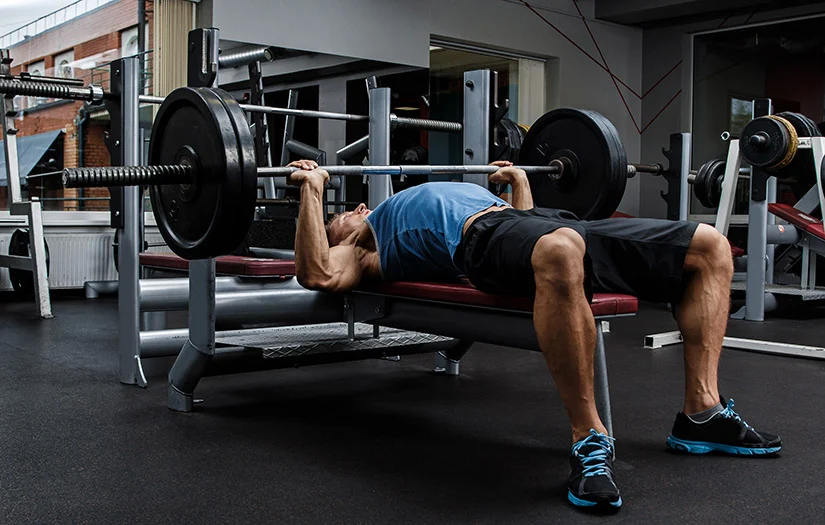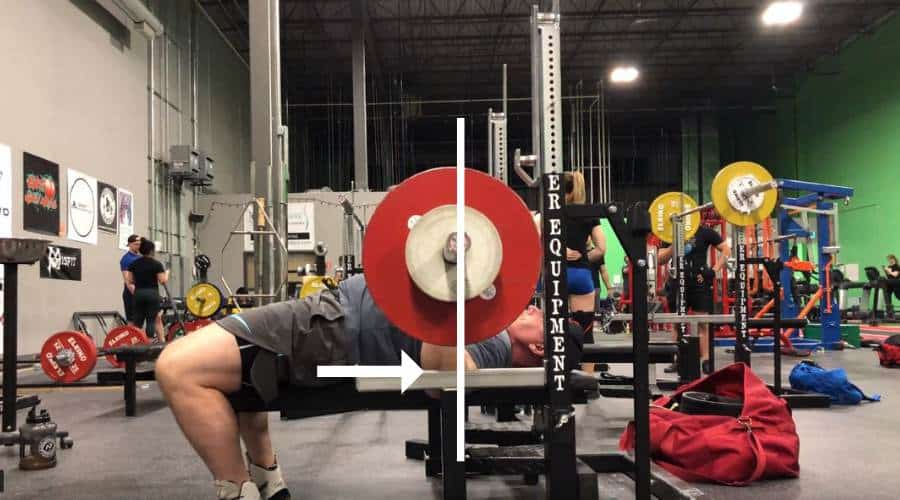Should Your Elbows Be In or Out For Bench Press? | PowerliftingTechnique.com (original) (raw)
If your elbows are “in” it means that they are tucking closer to the body while benching. If your elbows are “out” it means that they are flaring away from the body while benching.
So, should your elbows be in or out for bench press? The elbows should either be slightly in or directly in line with the barbell when the weight is on the chest. This position will be the most optimal way to transfer force from the shoulder girdle, through the arms, and to the barbell. What you want to avoid is the elbows being ‘behind the bar', or flared out, when the bar is on your chest. However, as you press off the chest, some flaring away from the body is acceptable.
Let's define these concepts a bit further, look at the benefits, and address common issues. I'll also share how you can best set up the “elbows in” position with one simply cue I use with my athletes.
If you get sore elbows while benching or want additional joint stability and protection, check out my guide on ELBOW SLEEVES FOR BENCH PRESS
Table of Contents
Toggle
- The Difference Between a Bodybuilding and Powerlifting Style Bench Press
- Want to improve your bench press technique?
- The “In” And “Out” Elbow Position: Tucking vs Flaring
- How Your Grip Changes Your Elbow Position
- Common Problems
- How to Set-Up Your Elbow Position on Bench Press: One Simple Cue
- Final Thoughts
The Difference Between a Bodybuilding and Powerlifting Style Bench Press
You might notice that bodybuilders and powerlifters have two different styles of bench press.
For the bodybuilder, they usually touch slightly higher on their chest with their elbows flared out. For the powerlifter, they usually touch slightly lower with their elbows tucked in.
Neither is wrong, but it comes down to the goal of each movement and the muscles involved in both styles of technique.
When the bodybuilder is benching, their goal is to isolate their chest muscles as much as possible. So with the elbows flared out, there is greater activation through the chest compared with any other muscle group, especially as it relates to the upper pecs. Because bodybuilders are not concerned with how much weight they're lifting, the loads will be lighter, and they'll be focused more on the ‘mind-muscle' connection.
When the powerlifter is benching, their goal is not to isolate one muscle group over another, but to lift as much weight as possible. This fundamentally changes the technique involved in order to recruit the maximum musculature. By tucking the elbows in, powerlifters are still utilizing the pecs, but bringing in the triceps to help leverage the movement. Powerlifters are less concerned about the ‘mind-muscle' connection, and more focused on the applied forces of the movement.
In order to properly tuck the elbows, powerlifters like to use the bench cue “bend the bar“, which you can read about in my other article.
One quick note:
I would argue that even bodybuilders need to have some elbow tucking because bench press should be used as a compound movement to gain strength, not an isolation movement to improve mind-muscle connection. In order for bodybuilders to achieve continued hypertrophy (muscle growth) they need to move more weight, for more volume over time.
Check out my full guide on the POWERLIFTING VS BODYBUILDING BENCH PRESS

Want to improve your bench press technique?
The “In” And “Out” Elbow Position: Tucking vs Flaring
Let's take a look at a few examples of what it looks like to have your elbows “in” or “out” during bench press.
Record the side angle of your bench press and wait until the bar is on your chest (feel free to do this analysis with your own bench press).

Elbow is in front of the line of barbell
When the bar is on your chest, you'll want to draw a straight line down starting from the bar. What you're trying to notice is where your elbows are positioned in relation to this line. Are they in front, behind, or directly in line?
The position that you're trying to achieve is to have your elbows either directly in line with the bar or just slightly in front. This was one of the key things I mentioned in my article on 19 Bench Press Mistakes.
Here's how Shane Martin describes elbow position for Bench Press (the strongest pound-for-pound bench pressor in Canadian History):

Shane Martin, 715lbs bench press @ 264lb bodyweight
The best elbow position would be where your elbow continues to track underneath the barbell, or slightly infront of it, during the touch and press. This allows you to leverage your elbow joint to push the barbell upwards in the most mechanically advantageous position. As you press the the bar upwards, your elbow should follow under the barbell with a few degrees forward travelling towards your face.
One of the other key positions you're trying to optimize for is having your hands and wrists stacked directly over the forearm. I'll bring this up again in the next section when I start talking about grip width.
Check out my article on How To Switch From Bodybuilding to Powerlifting
How Your Grip Changes Your Elbow Position
The exact position is going to depend on someone's individual mechanics (length of upper arm, forearm, and torso).
This is why there's a ‘range' that's considered optimal rather than an exact degree to which your elbows should be positioned. The general rule of thumb is to ‘do what feels natural', and don't obsess about the angles so much. As long as you're somewhere within the elbows being directly in line with the bar or slightly in front, you'll be able to apply the correct force to the barbell, get stronger, and keep your shoulders/elbows safe.
With that said, grip is definitely something to consider when deciding where your elbows should be.
Without knowing someone's individual mechanics, a narrower grip will have more elbow tuck, whereas a wider grip will have more elbow flare. Generally speaking, a narrower grip can be defined as around ‘shoulder-width', and a wider grip can be defined as around 1.5-2X shoulder width.
The grip distance on the bar will affect the bar trajectory — how the bar moves from your start position to your chest. In a narrower grip, you'll need to touch the bar lower on your chest. In a wider grip, you'll need to touch the bar higher on your chest.
The lower you touch, the more elbow tuck that's required to keep your hands and wrists stacked directly over the forearm. Learn more about bar path, grip, and elbow position in my article on bench press cues.
I also wrote an entire article on the Reverse Grip Bench Press, which requires more elbow tucking compared with a regular bench press.
Common Problems
The most common problems are probably obvious, but they're important to mention.
Too Much Tucking
If you tuck your elbows too much you'll likely experience some elbow soreness (especially on the inside of the elbow). An example of this is if your elbows were touching your rib cage when the weight is on your chest. Too much tucking can feel like the bench press is turning into a ‘skull crusher' movement.
Most people likely over-tuck their elbows when first starting to experiment with elbow positioning on bench press. The cue I suggest in the next section will help prevent over-tucking.
If you ever get elbow pain when benching, then make sure to check out my complete guide on how to avoid it.
Too Much Flaring
If you flare your elbows too much you'll likely experience some shoulder soreness, especially if the elbow flaring happens when the weight is on your chest. This will look like ‘tipping the bar forward' to touch your chest rather than bringing the bar straight down. It will feel fairly unstable on the chest and that you're losing the bar forward on the chest (toward the stomach).
I don't see this issue too often, but it does happen. It's typically caused by having weaker triceps, which causes you to shift the loading demands to your chest and shoulders in order to leverage the movement. Of course, you want to load the chest and shoulders while benching, but you don't want to take your triceps out of the movement entirely.
Check out my article on what to do if you're weak off the chest in the bench press.
How to Set-Up Your Elbow Position on Bench Press: One Simple Cue
You should be setting up your elbow position for bench press before you start the descent.
As you take the bar up and out of the rack, you'll be holding the bar over your chest with straight arms. From this position, you'll want to do a 1/4 inward rotation of your elbows. This 1/4 inward rotation can be achieved by thinking about ‘bending the bar' in half. As you ‘bend the bar', your elbows will rotate inward.
Let me be clear: the inward rotation needs to be very subtle. The idea is NOT to crank your elbows so much that when you start benching they're touching the side of your body. Rather, the 1/4 inward rotation will allow for a natural ‘tuck' when you begin the descent.
You might hear coaches cue athletes to ‘tuck' the elbows as they're bringing the bar down to their chest — ‘TUCK, TUCK, TUCK' they'll say. I don't like this cue at all. I think cueing elbow position when you've already started to bench is a waste of cognitive effort. If you set-up your elbow position like I've described by rotating your elbows inward, you'll already have your elbows tucking properly before you start the movement.
Here's a video of me talking about how to cue your elbow position during the set-up of the bench press:
Final Thoughts
Your elbows can either be just slightly in front or inline with the barbell when the weight is on your chest. As long as you're within this range, you're optimized to lift the most weight possible in a powerlifting-style bench press.
If you find your biceps hurt while benching, check out my article on How To Fix Bicep Pain While Bench Pressing.